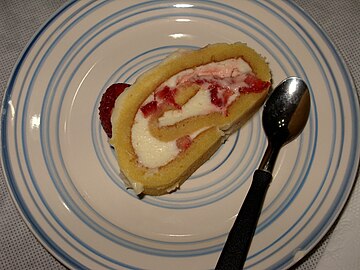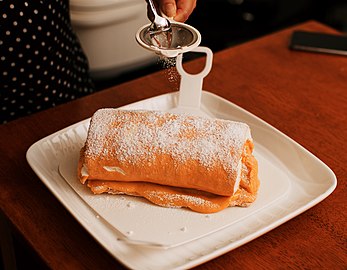Pionono
 | |
| Type | Pastry |
|---|---|
| Place of origin | Spain |
Pionono describes different sweet or savory pastries from Granada, Spain, the Philippines, South America, and the Caribbean. They are named after Pope Pius IX's name in Italian, Pío Nono.[1][2]
By country
[edit]Spain
[edit]Spanish Piononos are small pastries traditional in Santa Fe, a small town adjacent to the city of Granada, Spain, which is otherwise known primarily for the Capitulations of Santa Fe between Columbus and the Catholic Monarchs.[3] A pionono has two parts: a thin layer of pastry rolled into a cylinder, drenched with different kinds of syrup which give the pionono a sweet and pleasant texture, and crowned with toasted cream. It is typically eaten in one or two bites.
Philippines
[edit]
In the Philippines, pionono is more commonly spelled as pianono. It is a rolled sponge cake and is more accurately a type of jelly roll. It consists of a layer of pastry made from eggs, sugar, and sifted flour baked in a sheet. Once cooled, jelly or other types of filling is spread over the pastry. It is then rolled from one end to the other. Its most common traditional filling is simply sugar and butter (or margarine), similar to the other forms of the Filipino mamón (sponge cakes). Modern versions, however, are commonly frosted and can include a variety of fillings.[4][5]
South America and Cuba
[edit]In various South American countries such as Argentina, Uruguay, Paraguay, Venezuela, Colombia, Peru and in Cuba, piononos are prepared using a dough made of flour, eggs, and sugar, which is baked in a thin sheet then rolled around a filling of dulce de leche sometimes with walnuts, or fruits like strawberries with chantilly cream, or in the case of savory piononos with cured ham, cheese, tomato and mayonnaise, or a savory salad, such as ham salad with asparagus and lettuce, chicken salad or even tuna. A similar cake is called "Brazo de Gitano" or "Brazo Gitano" in Cuba, Spain, and several other Spanish-speaking countries. In Uruguay a similar preparation called massini is not rolled and its dough is filled in between with whipped cream and covered with burnt yolks.
Puerto Rico (U.S.)
[edit]In Puerto Rico, piononos are prepared using ripe, or yellow, plantains as the "bread" around a savory filling. Plantains are sliced length wise and fried to make it more pliable to wrap around the filling. Picadillo, seafood, lunch meat, or vegetables topped with cheese are typical fillings; the whole sandwich is dipped in a batter made from flour and eggs and then deep-fried, or baked with no batter.
Gallery
[edit]-
Piononos from Málaga
-
Piononos from Santa Fe, Spain
-
Homemade Argentine piononos
-
Sliced Savory Argentine pionono, with Ham, cheese, Salsa golf and vegetables
-
Sweet Argentine piononos
-
Sliced sweet Argentine pionono
-
Sweet Argentine piononos with dulce de leche
See also
[edit]References
[edit]- ^ Fenix, Mickey (28 August 2014). "'Bibingka,' 'monay,' 'escandaloza' and other curious names of Philippine baked goodies". Inquirer.net. Retrieved 4 December 2014.
- ^ Ocampo, Ambeth R. (9 January 2015). "From Pius IX to 'Pio Nono'". Philippine Daily Inquirer. Retrieved 22 April 2019.
- ^ "Pueblos de Granada: Santa Fe". turgranada.es. Retrieved 10 October 2018.
Santa Fe is known as the 'Hispanic cradle'. It was the town where the Reconquista culminated and where the Capitulations of Santa Fe were signed, a treaty securing the funding for the journey which led to the discovery of America by Christopher Columbus, the explorer from Genoa.
- ^ "Pianono". Ang Sarap. 28 July 2017. Retrieved 22 April 2019.
- ^ "Pianono (Filipino Sponge Cake Roll)". Kawaling Pinoy. 23 April 2018. Retrieved 22 April 2019.
External links
[edit]









